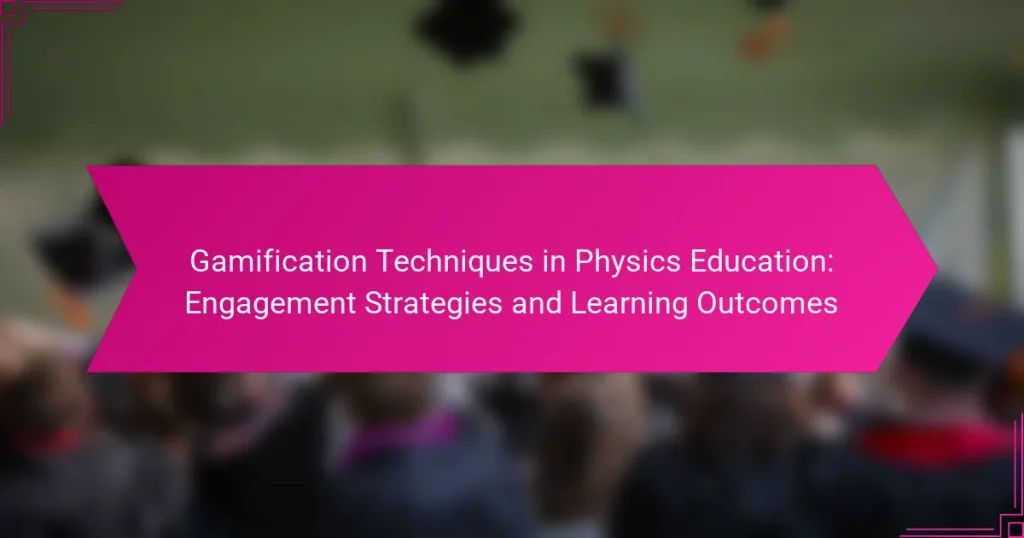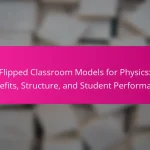Gamification techniques in physics education integrate game elements into the learning process to enhance student engagement and motivation. Key strategies include point systems, leaderboards, badges, and interactive simulations, which encourage active participation and foster a competitive yet collaborative environment. Research indicates that these methods can lead to improved learning outcomes, as evidenced by studies showing increased student motivation and performance. Gamification not only aids in the retention of complex physics concepts but also promotes problem-solving skills and teamwork among learners, ultimately supporting a deeper understanding and application of physics knowledge.
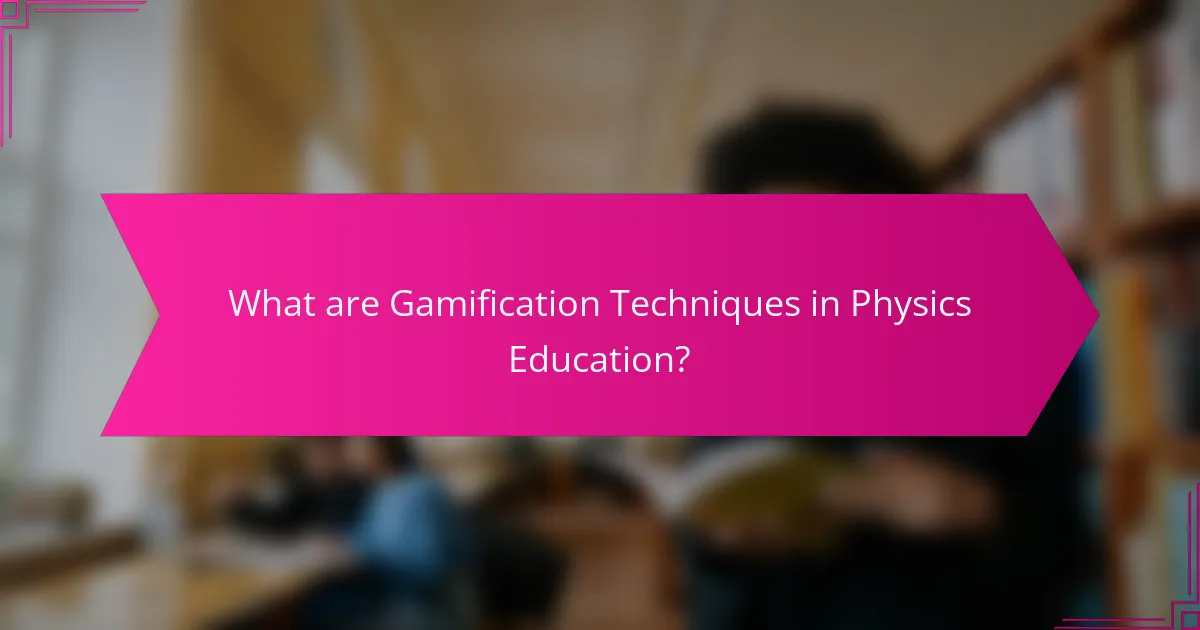
What are Gamification Techniques in Physics Education?
Gamification techniques in physics education involve integrating game elements into the learning process. These techniques aim to enhance student engagement and motivation. Common techniques include point scoring, leaderboards, and badges. Interactive simulations and problem-solving games are also utilized. These methods encourage active participation and foster a competitive yet collaborative environment. Research indicates that gamification can lead to improved learning outcomes. For instance, a study by Hamari et al. (2014) shows that gamification increases student motivation and performance in educational settings.
How do gamification techniques enhance student engagement in physics?
Gamification techniques enhance student engagement in physics by incorporating game-like elements into the learning process. These techniques include point systems, badges, and leaderboards, which motivate students to participate actively. Engaging students through challenges and rewards makes learning more interactive. Research shows that gamification can increase student motivation by up to 60%. Additionally, it fosters a sense of competition and achievement. Students are more likely to collaborate and communicate when working towards common goals. This collaborative environment enhances peer learning and knowledge retention. Overall, gamification transforms traditional physics education into a dynamic and engaging experience.
What specific elements of gamification contribute to increased motivation?
Specific elements of gamification that contribute to increased motivation include rewards, challenges, and feedback. Rewards provide tangible incentives, such as points or badges, which encourage continued participation. Challenges create a sense of achievement and push learners to improve their skills. Feedback offers immediate responses to actions, helping learners understand their progress. Research indicates that these elements foster a sense of autonomy and competence. For instance, a study by Deterding et al. (2011) highlights how gamification enhances user engagement through these motivational factors.
How do these techniques cater to different learning styles in physics?
Gamification techniques cater to different learning styles in physics by incorporating diverse methods that engage visual, auditory, and kinesthetic learners. Visual learners benefit from interactive simulations and graphical representations of concepts. Auditory learners gain from podcasts and discussions that explain physics principles. Kinesthetic learners engage through hands-on activities and experiments that allow them to physically manipulate objects. Research shows that using varied instructional strategies increases student motivation and retention of information. For example, a study by Hamari et al. (2016) indicates that gamification enhances learning outcomes by addressing individual preferences. Thus, these techniques effectively support multiple learning styles in physics education.
Why is engagement important in physics education?
Engagement is crucial in physics education because it enhances student motivation and understanding. Engaged students are more likely to participate actively in lessons. This active participation leads to deeper comprehension of complex physics concepts. Research shows that students who are engaged tend to perform better academically. For instance, a study published in the “Journal of Educational Psychology” found that increased engagement correlates with higher test scores in physics. Furthermore, engagement fosters critical thinking and problem-solving skills. These skills are essential for success in physics and related fields. Overall, engagement in physics education promotes a more effective and enjoyable learning experience.
How does student engagement impact learning outcomes in physics?
Student engagement significantly enhances learning outcomes in physics. Engaged students demonstrate higher motivation and interest in the subject. This leads to improved understanding of complex concepts. Research shows that active participation can increase retention rates. A study by Fredricks et al. (2004) indicates that engaged students achieve better academic performance. They are more likely to participate in discussions and group work. This collaborative environment fosters deeper learning. Engaged students also tend to seek help when needed. As a result, they develop critical thinking skills essential for physics. Overall, higher engagement correlates with improved learning outcomes in physics education.
What are the long-term benefits of engaging physics education?
Engaging in physics education offers long-term benefits such as enhanced problem-solving skills and critical thinking abilities. Students develop a deeper understanding of scientific concepts. This foundational knowledge supports advanced studies in STEM fields. Research indicates that students who engage in physics show improved analytical skills. According to a study by the American Association of Physics Teachers, students retain knowledge longer when actively involved in learning. Additionally, physics education fosters creativity and innovation. These skills are vital in various careers, from engineering to technology. Engaging in physics also promotes collaboration and communication skills through group projects and discussions. Overall, the long-term benefits of engaging in physics education significantly contribute to personal and professional development.
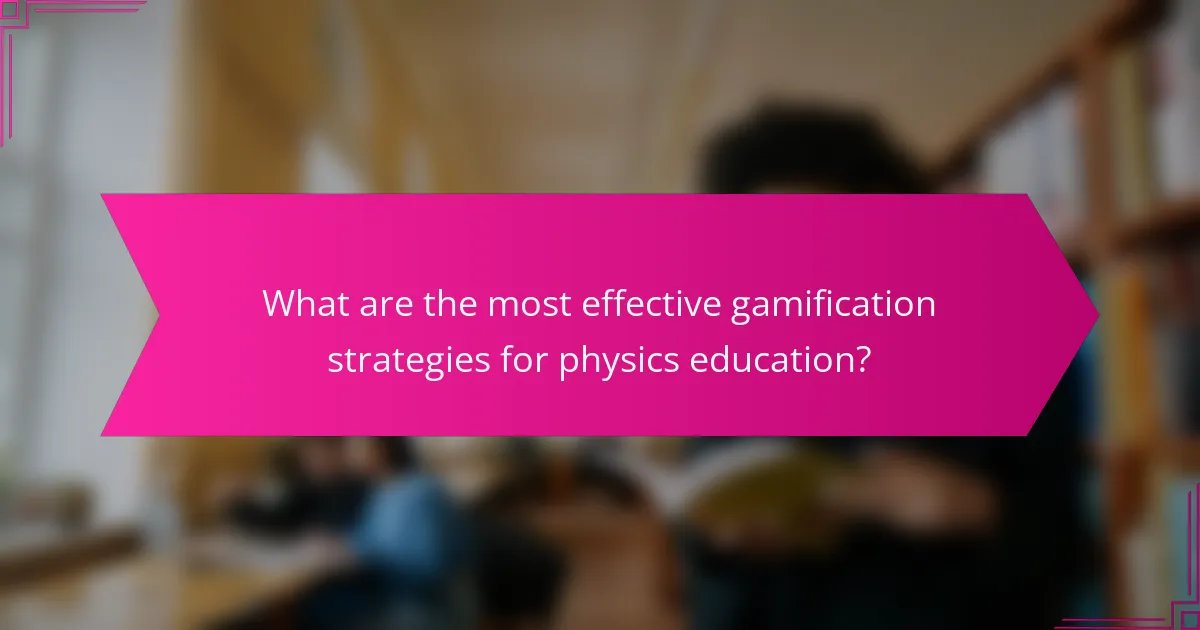
What are the most effective gamification strategies for physics education?
Effective gamification strategies for physics education include point systems, leaderboards, and interactive simulations. Point systems reward students for completing tasks, enhancing motivation. Leaderboards create a competitive environment that encourages participation. Interactive simulations allow students to experiment with physics concepts in a virtual setting. Research shows that these strategies improve engagement and retention of knowledge. A study by Hamari et al. (2016) found that gamification significantly increases student motivation and performance in educational contexts. These strategies foster a sense of achievement and community among learners.
How can game-based learning be integrated into physics curricula?
Game-based learning can be integrated into physics curricula through interactive simulations and educational games. These tools allow students to explore complex concepts in a hands-on manner. For example, simulations can demonstrate principles like motion and energy conservation. Educational games can reinforce learning by providing immediate feedback and rewards. Research shows that game-based learning increases student engagement and motivation. A study by Hamari et al. (2016) found that gamification improves learning outcomes in educational settings. By incorporating these elements, educators can create a dynamic learning environment that enhances understanding of physics.
What types of game mechanics are most effective for teaching physics concepts?
Game mechanics that are most effective for teaching physics concepts include simulation, feedback systems, and challenge-based tasks. Simulation allows students to visualize and manipulate physical phenomena in a virtual environment. This interactive experience enhances understanding of complex concepts like motion and forces. Feedback systems provide immediate responses to student actions, reinforcing learning through trial and error. Challenge-based tasks engage students in problem-solving scenarios, fostering critical thinking and application of physics principles. Research shows that these mechanics improve student engagement and retention of physics concepts, as evidenced by studies in educational technology journals.
How can educators assess the effectiveness of game-based learning in physics?
Educators can assess the effectiveness of game-based learning in physics through various methods. They can utilize pre- and post-assessment tests to measure knowledge gains. Surveys and questionnaires can gather student feedback on engagement and learning experiences. Observational studies can track student interactions and participation during game-based activities. Performance metrics, such as grades and completion rates, can indicate learning outcomes. Additionally, educators can analyze the correlation between game-based learning and improved problem-solving skills. Research shows that game-based learning can enhance motivation and retention in physics concepts, supporting its effectiveness.
What role do rewards and feedback play in gamification?
Rewards and feedback play a crucial role in gamification by enhancing motivation and engagement. Rewards can be intrinsic or extrinsic, providing users with recognition or tangible benefits for their achievements. Feedback informs users about their progress and areas for improvement, fostering a sense of competence. Research shows that timely and constructive feedback increases learner satisfaction and retention. A study by Hamari et al. (2016) demonstrated that feedback in gamified environments significantly boosts user participation and learning outcomes. Thus, effective rewards and feedback mechanisms are essential for successful gamification strategies in educational contexts.
How can immediate feedback enhance the learning experience in physics?
Immediate feedback enhances the learning experience in physics by providing students with timely information about their understanding. This allows learners to identify misconceptions quickly. Research shows that immediate feedback can improve retention rates by up to 25%. It also encourages active engagement, as students can adjust their strategies based on the feedback received. This dynamic interaction fosters a deeper comprehension of complex physics concepts. Furthermore, immediate feedback can motivate students to take ownership of their learning process. Studies indicate that students who receive prompt feedback are more likely to persist in challenging tasks. Overall, immediate feedback serves as a crucial tool in enhancing physics education outcomes.
What types of rewards are most motivating for physics students?
Intrinsic rewards, such as personal achievement and mastery of concepts, are highly motivating for physics students. These rewards foster a sense of accomplishment and encourage deeper engagement with the material. Extrinsic rewards, including points, badges, and recognition, also play a significant role in motivating students. Research indicates that a combination of intrinsic and extrinsic rewards can enhance student motivation and learning outcomes. For instance, a study by Hamari et al. (2014) found that gamification elements positively impact student engagement in educational settings. This evidence suggests that both types of rewards are effective in motivating physics students.
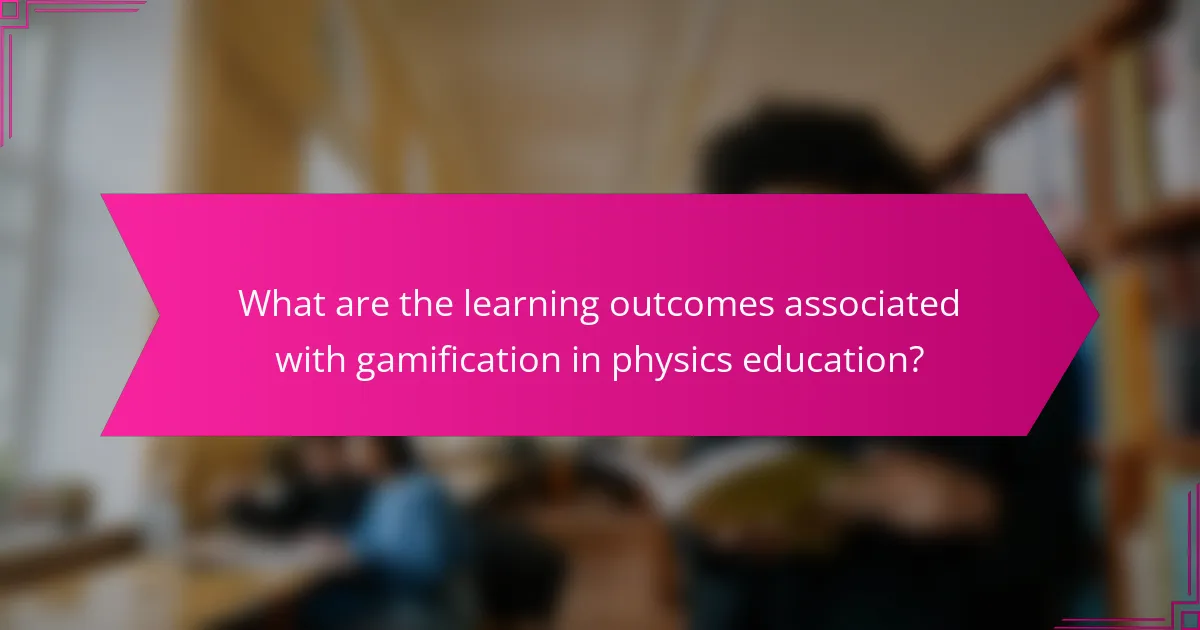
What are the learning outcomes associated with gamification in physics education?
Gamification in physics education leads to enhanced student engagement and improved learning outcomes. Students experience increased motivation through game-like elements. This approach fosters active participation in the learning process. Research shows that gamification can improve problem-solving skills in physics. Additionally, it encourages collaboration among students, enhancing teamwork abilities. Gamification also aids in the retention of complex physics concepts. A study by Deterding et al. (2011) highlights these benefits, noting significant improvements in student performance. Overall, gamification effectively supports deeper understanding and application of physics knowledge.
How does gamification influence students’ understanding of physics concepts?
Gamification enhances students’ understanding of physics concepts by increasing engagement and motivation. When students participate in game-like activities, they are more likely to actively engage with the material. This active participation leads to improved retention of physics concepts. Research shows that gamified learning environments can lead to higher academic performance. For example, a study by Hamari et al. (2016) found that gamification positively affects learning outcomes. The interactive nature of gamification allows students to visualize and apply physics principles in real-world scenarios. This practical application helps solidify their understanding of complex concepts. Overall, gamification serves as an effective tool in physics education.
What specific skills can students develop through gamified physics learning?
Students can develop critical thinking, problem-solving, collaboration, and engagement skills through gamified physics learning. Gamification introduces challenges that require students to analyze situations and devise solutions. It encourages them to think critically about physics concepts. Students also learn to collaborate with peers in team-based challenges. This teamwork fosters communication and interpersonal skills. Gamified elements enhance student engagement, making learning more enjoyable and motivating. Research shows that active participation in gamified environments improves retention of physics knowledge. Overall, gamified physics learning cultivates a diverse skill set essential for academic and real-world applications.
How does gamification affect students’ attitudes towards physics as a subject?
Gamification positively affects students’ attitudes towards physics by increasing engagement and motivation. It transforms traditional learning into an interactive experience. Students often show improved interest in physics concepts through game-like elements. Research indicates that gamified learning environments enhance students’ perceived relevance of physics. A study by Hamari et al. (2016) found that gamification fosters greater intrinsic motivation. This motivation leads to a more favorable attitude towards the subject. Moreover, students report higher satisfaction and enjoyment when learning through gamified methods. Overall, gamification creates a more enjoyable and effective learning atmosphere for physics.
What challenges do educators face when implementing gamification in physics?
Educators face several challenges when implementing gamification in physics. One significant challenge is the lack of resources and training. Many educators are unfamiliar with gamification strategies and require professional development to effectively integrate them into their teaching. Another challenge is the varying levels of student motivation. Not all students respond positively to gamified elements, making it difficult to engage everyone. Additionally, aligning gamification with curriculum standards can be complex. Educators must ensure that gamified activities meet educational objectives while keeping them engaging. Time constraints also pose a challenge. Designing and implementing gamified lessons can be time-consuming, detracting from other instructional responsibilities. Lastly, measuring the effectiveness of gamification in enhancing learning outcomes can be difficult. Educators need reliable assessment methods to evaluate the impact of gamification on student understanding in physics.
How can educators overcome resistance to gamification in the classroom?
Educators can overcome resistance to gamification in the classroom by clearly demonstrating its educational benefits. Research shows that gamification can enhance student engagement and motivation. Educators should provide training on gamification strategies to increase comfort levels. Sharing success stories from other classrooms can also alleviate concerns. Additionally, involving students in the design of gamified elements fosters ownership and acceptance. Regular feedback from students can help refine gamification approaches. Lastly, addressing misconceptions about gamification as merely play can clarify its educational purpose.
What are common pitfalls to avoid when using gamification in physics education?
Common pitfalls to avoid when using gamification in physics education include overemphasis on rewards. This can lead to students focusing on points instead of learning. Lack of clear educational objectives is another issue. Without defined goals, students may not understand the purpose of activities. Additionally, ignoring diverse learning styles can alienate some students. Gamification should cater to various preferences for maximum engagement.
Implementing overly complex game mechanics can also confuse students. Simplicity often enhances understanding and participation. Lastly, failing to provide meaningful feedback can hinder student progress. Regular, constructive feedback is essential for effective learning.
What best practices should educators follow when applying gamification techniques in physics?
Educators should incorporate clear objectives when applying gamification techniques in physics. Setting specific learning goals enhances focus and direction. Integrating game mechanics such as points, badges, and leaderboards can motivate students. Research shows that these elements increase engagement and participation. Providing immediate feedback is essential to help students understand their progress. This approach allows for timely adjustments in learning strategies. Creating collaborative challenges encourages teamwork and communication among students. Studies indicate that collaboration enhances problem-solving skills in physics. Finally, regularly assessing the effectiveness of gamification strategies ensures continuous improvement in teaching methods.
How can teachers effectively design gamified lessons for physics education?
Teachers can effectively design gamified lessons for physics education by integrating game mechanics into the learning process. This approach includes setting clear learning objectives that align with game elements. Teachers should create challenges that encourage problem-solving and critical thinking. Incorporating rewards, such as points or badges, can motivate students to engage with the material.
Utilizing technology, such as interactive simulations or educational games, enhances the learning experience. Collaborative activities, like team-based challenges, foster communication and teamwork among students. Regular feedback helps students understand their progress and areas for improvement. Research shows that gamified learning increases student engagement and retention of physics concepts.
What resources are available for educators looking to implement gamification in physics?
Educators can access various resources to implement gamification in physics. Online platforms like Kahoot! and Quizizz provide interactive quiz tools. Websites such as Classcraft offer gamified classroom management solutions. The Physics Classroom and PhET Interactive Simulations provide engaging physics simulations and activities. Additionally, books like “Gamify Your Classroom” by Matthew Farber offer practical strategies. Research studies, such as “The Impact of Gamification on Student Engagement” by Deterding et al., provide evidence of effectiveness. These resources equip educators with tools and strategies to enhance student engagement in physics.
Gamification techniques in physics education involve integrating game elements to enhance student engagement and motivation. Key strategies include point systems, badges, leaderboards, and interactive simulations, which foster active participation and collaboration among learners. Research indicates that these techniques can significantly improve learning outcomes, critical thinking, and retention of complex concepts. The article explores the effectiveness of various gamification strategies, their impact on different learning styles, and the long-term benefits of engaging physics education, while also addressing challenges and best practices for educators implementing these techniques.
